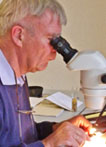|
Comments |
Deceased (2019). Worked as a free lance cooperator at the Museum for Central Africa in Tervuren, mainly on the Cyprinodontiformes fishes, Aplocheilichthyinae and Nothobranchinae in particular. Contributed information and fish pictures to FishBase.
Rudolf "Ruud" Hans Wildekamp
February 6, 1945 - August 18, 2019
When Ruud was about 18 years of age he enlisted in the Dutch Air Force as a professional soldier and became a radio and radar technician at the Volkel Air Base. Among other places, he was sent to Turkey in 1981 where, in his spare time, he discovered habitats of Aphanius species and collected some fish that found their way back to the Netherlands. During the period 1989-1999, he returned to Turkey on numerous occasions to further study and collect these species and to participate in a major research project there. In later years, his duties with the air force changed and he was put in charge of a group whose job it was to discourage birds from frequenting the runways, which could be a serious hazard to jet aircraft.
One of Ruud’s many talents was his artistic ability and, since the early 1970s, he produced the most exquisite and technically accurate ink line drawings of almost all known killifish. His ability to capture the distinctive features of each species and populations thereof, in black and white, was nothing short of remarkable. In the early years, especially when printing technology was not as advanced as it is today and when the inclusion of photographs of fish was relatively uncommon in publications, Ruud’s small works of killifish art were used extensively as illustrations. He produced so many such drawings that, when asked him how he found the time to do so, he said that he usually drew one a day during his lunch
break at work!
Ruud’s interest in the science of killifish led to many field trips, at least 27, during the period 1976-2005. Some of the countries visited during the course of such field investigations were: Tanzania, Somalia, Kenya, Uganda, Mozambique, South Africa, Tchad, Nigeria, Turkey, Corfu and Brazil. Aside from his vast knowledge of killifish, especially of Nothobranchius, he would amaze his field companions with the ability to identify any freshwater fish that came into our nets or that he spotted while checking what was available in the local fish markets and by talking to local fishermen. He systematically preserved
killifish specimens which were used later for research purposes and, ultimately, the majority of those ended up in museum collections.
For over 40 years Ruud was an associate taxonomist at the Royal Museum for Central Africa in Tervuren, Belgium. He was responsible for the majority of killifish identifications in the collection at RMCA and worked with Max Poll, Dirk Thijs Van den Audenaerde, Guy Teugels, Jos Snoeks and Emmanuel Vreven.
Much of the field data and specimens he collected also formed the basis for his many descriptions of new species. He authored or co-authored about 40 original descriptions plus a number of redescriptions, predominantly of Nothobranchius species but also of various lampeyes, and Fundulopanchax, Aphanius and Aphyosemion species. Ruud was an extremely prolific writer of both hobbyist-oriented articles, published in various killifish association journals and magazines, as well as scientific papers published in professional journals. He also wrote numerous books or contributed chapters to books. His professional-type publications, scientific and technical articles and papers, exceed 130 items. In addition, the number of hobbyist-type articles that he wrote would surely number more than that. He was highly respected in the scientific community and regarded as an authority on many aspects of killifish. A truly remarkable achievement when one considers that he did not have the benefit of a formal training in ichthyology.
Ruud’s contributions to the study of killifish have been recognised by having two new species named after him: Aphyosemion wildekampi by Berkenkamp in 1973 and Nothobranchius ruudwildekampi by Costa in 2009.
Brian Watters, Wim Suijker and Jouke van der Zee |

